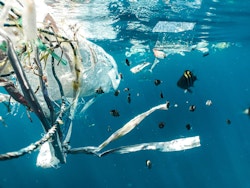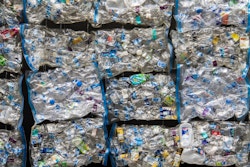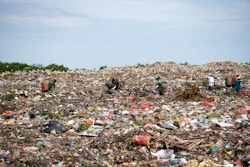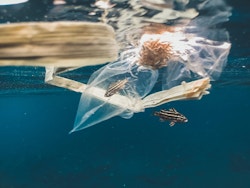Plastic pollution's impact on marine biodiversity
The Energy Observer catamaran is currently cruising the seas of Southeast Asia, in Indonesia. An opportunity for us to come back to a major threat that harms our oceans and that particularly concerns the Indonesian archipelago: plastic pollution. Katia Nicolet, our onboard scientist and expert in marine biology explains more about the phenomenon.

The second largest contributor of ocean plastic debris
Indonesia is a vast archipelago of over 17,000 islands stretching 5,000 km in length, from Sumatra in the west to West Papua in the east. It is also the fourth most populous country in the world, with the majority of people living along the coasts. Unfortunately, this also makes Indonesia the second largest contributor of ocean plastic debris. Each year, 600,000 tons of plastic are dumped into the ocean along the Indonesia coasts. This waste is not all endogenous, however, since Indonesia -like many countries in Asia- receives cargo ships full of plastics from Western countries. Indeed, paying developing countries to deal with our garbage, and shipping said plastic across the world seems to be more economically viable than recycling it.
Whatever its origin, plastic debris, escaping from open dumpsites, will first pollute coastal ecosystems, such as mangroves, seagrass beds and coral reefs, before being washed away into the ocean. At each stage, the impact on the marine environment is disastrous, causing various issues associated with each stage of fragmentation.
To better understand the phenomenon, let's get back to the basics. What are plastics? How do they end up in our oceans? What impacts do they have once in the aquatic ecosystems?

Waste dump sites in Bali
What are plastics?
Plastics are a derivative of hydrocarbon (petroleum or coal) heated between 20 and 180˚C to obtain a transparent liquid close to gasoline (called naphtha). This liquid is then broken up into monomers: short molecules made up of carbon and hydrogen. These short molecules, like train cars, can be put together to form larger ones called polymers. Polymers are the basis of all plastics, and to obtain different shapes, colors and properties, additives are added to the mix. This is how we get flexible or stretchable plastics, fire-resistant or waterproof ones, and plastics of various colors and transparencies.
An everyday material made indispensable
Plastics are everywhere: in our food packaging, our clothes, the floors of our schools, the plumbing of our homes, our paints, our cosmetics and even our tea bags. It i's hard to imagine a world without them, and yet their invention is very recent! We have discovered how to make synthetic polymers in the 1930s, and it is in the few decades that followed that we saw the invention and diversification of most plastics.
With their versatility, plastics have invaded our lives. So, what? Don’t they bring us a comfort previously unimaginable? Yes, but at what cost?

Today, plastics are classified into seven categories, and their logos (the arrows in triangle) appear on the back of our packaging.
- PET – Polyethylene terephthalate: bottles, single-use bags, polyester fibers
- PEHD – High-density Polyethylene: bottle caps, milk or laundry bottles
- PVC – Polyvinyl chloride: Toys, flooring, window frame, medical appliances
- PELD – Low-density Polyethylene: reusable bags, coffee cups
- PP – Polypropylene: straws, food packaging, Tupperware
- PS – Polystyrene: eyeglasses frame, single-use cutleries, thermal insulation
- Other – Various plastics: nylon, acrylic, multi-layered materials
Plastic, an insoluble problem
The major issue with plastics comes precisely from their durability: they never biodegrade. Since they are a synthetic material, nature cannot assimilate them, and plastics fragment into smaller and smaller pieces, but never fully decompose. They, therefore, accumulate in the natural environment in various forms: macroplastics (> 5 cm), mesoplastics (5 mm to 5 cm) and microplastics (<5 mm).
Plastics are synonymous with waste. Because, although we have manufactured astronomical amounts of plastics and although they can be recycled indefinitely, we do not, or seldom, recycle them. Since 1950, we have produced 8.3 billion tons of plastics, half of which are single-use (source: Geyer et al. 2017). 8.3 billion tons of plastics in 65 years (from 1950 to 2015), that is the equivalent of 4 tons of plastics per second! And 60% of this production ended up as waste, only 9% was recycled. It is now estimated that a total of 5 billion tons of plastic waste has ended its course in the environment: soils, rivers, mountains, forests, lakes and oceans.

Waste dump sites in Bali
This is an unbearable amount of plastic debris, now polluting the natural world, fragmenting under the effect of the wind, UV rays, waves and heat. Ripped plastic bags, disregarded plastic bottles, torn polyester textile fibers, invisible tire dust and bottle caps mixed with beach pebbles. This is where the second issue with plastics comes in: additives. Additives are chemical compounds added to polymers to give objects their properties. Their composition is often kept secret, but many are known to be toxic, and additives leak from plastics during use and fragmentation. In a study that looked at the composition of 34 everyday consumer goods (bottle, packaging, etc.), 1 411 different chemicals were detected (source: Zimmermann et al. 2019). Out of the 1 411 chemicals, only 260 could be identified and 192 were known as toxic. A toxicity that seeps out of plastics and increases its impact on the environment.
Resistant, very rarely recycled, often discharged in nature and non-biodegradable; plastics, whether large or small, constitute an alarming pollution for all ecosystems on the planet.
A natural world that chokes under our rubbish
5 billion tons of plastic waste in the environment ... It is such a large amount of debris that scientists believe plastics will be a geological marker of our time on Earth. We will be identifiable by our waste for geological eras to come ... But right now, nature suffers from our addiction to plastics.
Larger debris - macroplastics over 5cm such as ghost nets or packaging - present a direct risk of entanglement for a large number of species. They can also be mistaken for prey and ingested. We all have in mind the images of a sea turtle chewing on a plastic bag, or a deer the antlers caught in a nylon cord, or a dead shark in a driftnet. Entanglement can cause some species to die quickly through asphyxiation or strangulation but can also lead to injury and infection. The ingested debris cannot be digested and will generate a false sensation of satiety, gastric obstructions and ulcers. More than 800 animal species are impacted by macroplastics, and 100,000 turtles and marine mammals die because of macroplastic pollution every year. In seabirds, it is even worse: it is estimated that more than one million birds die from plastic overdose each year. These numbers, unfortunately, are probably vastly underestimated.

All the waste mentioned above, that is visible to the naked eye, represent only 1% of global pollution. Once in the ocean, some rubbish sinks and other floats. The floating debris fragment into smaller pieces before sinking as well. The vast majority of pollution is therefore invisible, having disappeared into the depth of the ocean or being too small to notice: the microplastics.
These microplastics, as they break down, release toxic additives into the environment. But because of their porous microstructure, they also absorb other pollutants already present in the environment such as pesticides, hydrocarbons and heavy metals. An explosive cocktail condensed in a fragment less than 5 mm wide - easily ingested and deadly. Each year, 23,000 tons of toxic substances are released into the ocean from plastic waste. These substances can have a direct impact on marine organisms. For example, the phytoplankton Prochlorocuccus - which alone produces 10% of the oxygen we breathe - has its photosynthetic activity hampered by the presence of plastic pollutants (source: Tetu et al. 2019). But toxins also have an indirect impact: small organisms, like krill, ingest them before they are themselves eaten by larger animals. A study detected the presence of microplastics in 3/4 of small crustacean samples, taken from the bottom of the six deepest Pacific Ocean trenches. Microplastics accumulate along the food chain and their toxicity increases: dolphins and other cetaceans contaminated with heavy metals develop tumors, polar bears poisoned with phthalates have difficulty reproducing. Plastics impact all organisms, from single-celled phytoplankton to the largest terrestrial carnivore.
Plastics everywhere
Plastics are toxic at all stages of their life: from the extraction of hydrocarbons, to their manufacture, to their use and degradation. The environment suffers from this toxicity, but so do we. Substances associated with plastics are suspected to be carcinogenic, neurotoxic, to affect the immune, renal and cardiovascular systems as well as the endocrine system. This world of plastic that we have created damages our health.

We cannot separate ourselves from the ecological crisis. Our fate is linked to that of the albatross killed by a stomach full of plastic. We need to break away from our plastic addiction immediately, and stop the flood of plastic waste from the source. Cleaning up beaches and oceans is important, but it is a losing battle if we do not stop producing more and more plastics. It is our lifestyle that must change. We need to refuse the “mighty plastic” and demand healthy, recyclable and biodegradable materials. Nature does it very well, only a few proteins form the basis of all things: from the spider's indestructible web, to the beetle’s hard shell, or the soft wings of the butterfly. All these proteins are non-toxic, biodegradable and naturally recycled by nature. Another world is possible.
Plastics are not inevitable, they are a choice.